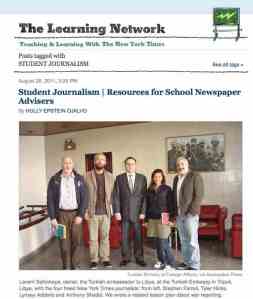 The New York Times’ Learning Network just ran a four-day Student Journalism Week. Fortunately, the four days of posts and numerous related resources are available online.
The New York Times’ Learning Network just ran a four-day Student Journalism Week. Fortunately, the four days of posts and numerous related resources are available online.
Here are three ways high school journalism teachers can benefit from these materials.
1. Help develop the rationale you use to promote the value of your high school journalism program.
Media adviser and JEA member Esther Wojcicki (“Freedom, Respect and High Expectations“) and Student Press Law Center Director Frank LoMonte (“The Case for High School Journalism“) both wrote articles that provide the kind of rationale for journalism programs that is helpful to share with school administrators, with the students who you are trying to recruit into high school media programs, and the students’ parents. You may need to share that rationale with some of teaching colleagues who may not be familiar with what is involved in a high school journalism program.
2. Find lesson plans that you can adapt to your journalism classroom.
Holly Epstein Ojalvo, the blogger for The Learning Network, provides links to several lesson plans, such as “Beyond Question: Learning the Art of Interviewing.”
3. Your students can practice writing their opinions about issues in the news.
The Learning Network provides a Student Opinion section. Students (13 and older) are given the opportunity to share their views on current news issues. Two recent issues were: “Have you experienced a severe weather event?” and “Do we need a new way to teach math?” You can lead a discussion with the class about structuring effective comments and realizing the impact of posting a comment on the New York Times’ Learning Network blog.
